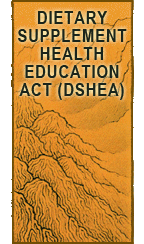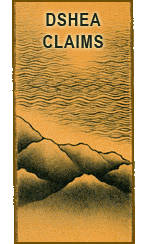DSHEA Tutorial: Conclusion and Future Actions

By now, it has probably become stunningly obvious to you that the DSHEA law, while protecting our ability to sell and promote our herbs, has also very much restricted our ability to do what we do.
Yin and yang arise together and while we can’t help people find safe and effective solutions to their diseases, we also benefit from this law that reins in the unethical marketers who can fool people into thinking that they’re getting the help they need when they’re really not.
 Last modified: August 13, 2009 ·
Last modified: August 13, 2009 ·  al ·
al ·  No Comments
No Comments
 Tags: Claims, DSHEA · Posted in: DSHEA
Tags: Claims, DSHEA · Posted in: DSHEA
DSHEA Tutorial: Disease Claim in Product Name

Non-Compliant Workaround #3: implying a disease claim through the name of the product.
Summary: You can’t hide a disease claim in the name of a product. However, hiding a claim to treat a non-disease state is okay. Using those allowed structure/function terms is also compliant.
 Last modified: August 13, 2009 ·
Last modified: August 13, 2009 ·  al ·
al ·  No Comments
No Comments
 Tags: Claims, DSHEA · Posted in: Claims
Tags: Claims, DSHEA · Posted in: Claims
DSHEA Tutorial: Ingredients’ Disease Claim

Non-Compliant Workaround #4: implying a disease claim through the disease treatment actions of any or all ingredients in the formula.
Summary: Individual ingredients cannot be said to treat disease states, however they can be said to maintain, regulate, support and other terms that do not imply disease treatment.
 Last modified: August 12, 2009 ·
Last modified: August 12, 2009 ·  al ·
al ·  No Comments
No Comments
 Tags: Claims, DSHEA · Posted in: Claims
Tags: Claims, DSHEA · Posted in: Claims
DSHEA Tutorial: Disease Claims Through Journal Citations

Non-Compliant Workaround #5: implying a disease claim by citing or referencing a peer reviewed journal or other authoritative source.
In particular, the FDA states that:
citation of a title referring to a disease will be treated as a disease claim, if, in the context of the labeling as a whole, the citation implies treatment or prevention of a disease, e.g., through placement on the immediate product label or packaging, inappropriate prominence, or lack of relationship to the product’s express claims.
 Last modified: August 11, 2009 ·
Last modified: August 11, 2009 ·  al ·
al ·  No Comments
No Comments
 Tags: Claims, DSHEA · Posted in: Claims
Tags: Claims, DSHEA · Posted in: Claims
DSHEA Tutorial: Disease Claims

This is kind of obvious. DSHEA says you can’t make claims that you fix a disease. This article restates this fact.
Non-Compliant Workaround #6: implying a disease claim by saying that the product has an effect on a disease.
You can file this under “duh”.
 Last modified: August 10, 2009 ·
Last modified: August 10, 2009 ·  al ·
al ·  No Comments
No Comments
 Tags: Claims, DSHEA · Posted in: Claims
Tags: Claims, DSHEA · Posted in: Claims
DSHEA Tutorial: Images or Symbols as Disease Claims

Non-Compliant Workaround #7: implying a disease claim with pictures, graphs, symbols or other means.
Summary: disease claims don’t have to be stated verbally. They can easily be made with images. An image making a disease claim is as non-compliant as the equivalent words.
Here’s the text from the FDA’s guidelines:
[A dietary supplement is out of compliance if it] (4) has an effect on disease through one or more of the following factors:
(e) use of pictures, vignettes, symbols, or other means;
 Last modified: August 9, 2009 ·
Last modified: August 9, 2009 ·  al ·
al ·  No Comments
No Comments
 Tags: Claims, DSHEA · Posted in: Claims
Tags: Claims, DSHEA · Posted in: Claims
DSHEA Tutorial: Drug Actions as a Disease Claim

Non-Compliant Workaround #8: implying a disease claim by suggesting that the product belongs to a class of products that is intended to diagnose, mitigate, treat, cure, or prevent a disease.
So, although formulas that clear “toxic heat” in TCM are commonly used for bacterial infections, we can’t just come out and say that!
Here’s an example of a prohibited product class labeling claim:
Huang Lian Jie Du Tang
(Coptis Detoxifying Decoction)
Chinese Herbal Antibiotic
 Last modified: August 8, 2009 ·
Last modified: August 8, 2009 ·  al ·
al ·  No Comments
No Comments
 Tags: Claims, DSHEA · Posted in: Claims
Tags: Claims, DSHEA · Posted in: Claims
DSHEA Tutorial: Herbs as Substitutes to Drugs

Non-Compliant Workaround #9: implying a disease claim by suggesting that the product is a substitute for a product that is a therapy for a disease.
Summary: A formula claiming to mimik the action of a drug or being a replacement for a drug is making a disease claim because drugs treat disease, and supplements aren’t allowed to do that.
Example:
Xue Fu Zhu Yu Tang (Blood Mansion Eliminate Stasis Decoction)
Herbal Platelet Inhibitor
 Last modified: August 7, 2009 ·
Last modified: August 7, 2009 ·  al ·
al ·  No Comments
No Comments
 Tags: Claims, DSHEA · Posted in: Claims
Tags: Claims, DSHEA · Posted in: Claims
DSHEA Tutorial: Drug Augmentation Claims

Non-Compliant Workaround #10: implying a disease claim by suggesting that the product augments a particular therapy or drug action;
A product cannot claim to augment a therapy or drug intended to treat disease. An herbal supplement marketed to treat hypertension along side beta-blockers is still making a disease claim that it will lower high blood pressure.
For example:
Tian Ma Gou Teng Yin (Gastrodia and Uncaria Decoction)
Boosts efficacy of beta blockers 35%
 Last modified: August 6, 2009 ·
Last modified: August 6, 2009 ·  al ·
al ·  No Comments
No Comments
 Tags: Claims, DSHEA · Posted in: Claims
Tags: Claims, DSHEA · Posted in: Claims
DSHEA Tutorial: Treating Disease Vectors

Non-Compliant Workaround #11: implying a disease claim by suggesting that the product has a role in the body’s response to a disease or to a vector of disease.
This is kind of a tough one because many of us are taught that Chinese herbal medicines are more about stimulating the body to correct its disease state, not by treating the disease directly, but by strengthening the body’s natural disease fighting mechanisms.
For instance, drinking Gui Pi Tang for blood deficiency stimulates the production of blood. The mechanism is probably not by the ingestion of iron (pending chemical analysis of long yan rou), but by encouraging the digestion to work more effectively so that more iron is absorbed during the process of digestion. (I’m not stating this as fact, I’m just referencing a treatment principle to illustrate this non-compliant workaround).
 Last modified: August 5, 2009 ·
Last modified: August 5, 2009 ·  al ·
al ·  No Comments
No Comments
 Tags: Claims, DSHEA · Posted in: Claims
Tags: Claims, DSHEA · Posted in: Claims
